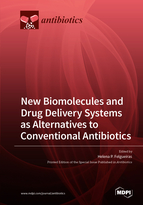New Biomolecules and Drug Delivery Systems as Alternatives to Conventional Antibiotics
A special issue of Antibiotics (ISSN 2079-6382). This special issue belongs to the section "Novel Antimicrobial Agents".
Deadline for manuscript submissions: closed (31 December 2021) | Viewed by 50931
Special Issue Editor
Interests: antimicrobial agents concomitant; synergistic and additive effects surface functionalization; antimicrobial properties; biomedical therapies; bioactive molecules; green synthesis; environmentally friendly; circular economy; waste materials’ second life
Special Issues, Collections and Topics in MDPI journals
Special Issue Information
Dear Colleagues,
New approaches to deal with the growing concern associated with antibiotic-resistant bacteria are in great demand. For many years, antibiotics have been widely employed to treat infections. However, their excessive consumption and misuse have accelerated the rise of antibiotic-resistant microorganisms, which constitute one of the dominant challenges to global health. The antibiotic crisis is now a general concern and alternative biomolecules or drug delivery systems to treat infections are, therefore, urgently needed. From natural extracts to traditional medicine remedies, to newly engineered nanocapsules and nanoparticles to bio-based, biodegradable delivery platforms, many systems to fight infections have been proposed.
This Special Issue seeks manuscript submissions that further our understanding of the antimicrobial action of specialized biomolecules, recently engineered or chemically modified from their ancient origins, as alternatives to conventional antibiotics. Submissions on the response of microorganisms to these agents, their contribution to infection control, and prevention of serious conditions/illnesses from occurring or evolving, are especially encouraged. Publications that aim at a deeper understanding of the synergistic effects between different biomolecules and/or biomaterials (as delivery platforms) in infected wound care and establish their advantageous performance as a new step towards the resolution of the antibiotic crisis are also very welcome.
Dr. Helena P. Felgueiras
Guest Editor
Manuscript Submission Information
Manuscripts should be submitted online at www.mdpi.com by registering and logging in to this website. Once you are registered, click here to go to the submission form. Manuscripts can be submitted until the deadline. All submissions that pass pre-check are peer-reviewed. Accepted papers will be published continuously in the journal (as soon as accepted) and will be listed together on the special issue website. Research articles, review articles as well as short communications are invited. For planned papers, a title and short abstract (about 100 words) can be sent to the Editorial Office for announcement on this website.
Submitted manuscripts should not have been published previously, nor be under consideration for publication elsewhere (except conference proceedings papers). All manuscripts are thoroughly refereed through a single-blind peer-review process. A guide for authors and other relevant information for submission of manuscripts is available on the Instructions for Authors page. Antibiotics is an international peer-reviewed open access monthly journal published by MDPI.
Please visit the Instructions for Authors page before submitting a manuscript. The Article Processing Charge (APC) for publication in this open access journal is 2900 CHF (Swiss Francs). Submitted papers should be well formatted and use good English. Authors may use MDPI's English editing service prior to publication or during author revisions.
Keywords
- Antimicrobial agents
- Infection control
- Baceria resistance
- Natural extracts
- Biomaterials functionalization
- Biological delivery systems
- Local and systemic drug administration
- Antibiotics world crisis







